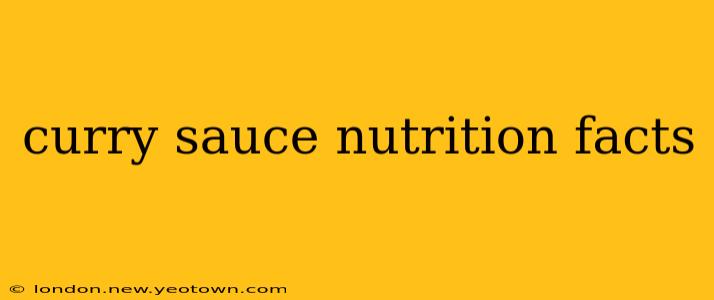Unmasking the Curry: A Deep Dive into Curry Sauce Nutrition
The aroma of simmering curry, a symphony of spices and fragrant herbs, is enough to transport you to exotic lands. But beyond its captivating scent and delicious taste lies a nutritional landscape as diverse as the curries themselves. Understanding the nutritional facts of curry sauce isn't just about counting calories; it's about appreciating the complex interplay of ingredients and their impact on our health. This journey into the world of curry sauce nutrition will unravel its secrets, revealing both its potential benefits and areas to be mindful of.
The truth is, there's no single "curry sauce." The nutritional profile varies wildly depending on the type of curry (Thai green, Indian butter chicken, Japanese kare roux, etc.), the ingredients used, and the cooking method. However, we can explore some commonalities and key factors influencing its nutritional content.
What are the main ingredients in curry sauce, and how do they affect its nutritional value?
This is where the story gets interesting. Imagine a vibrant tapestry woven from threads of diverse ingredients. The base often includes onions, garlic, and ginger – all powerhouses of antioxidants and beneficial compounds. Then come the spices: turmeric, known for its anti-inflammatory properties; cumin, rich in iron; coriander, a source of dietary fiber; and chili peppers, adding a kick while potentially boosting metabolism.
The "sauce" itself can be anything from a simple coconut milk base (high in healthy fats and calories) to a tomato-based sauce (rich in lycopene and vitamins), or even a creamy cashew or peanut sauce (offering protein and healthy fats). The protein source might be chicken, beef, tofu, lentils, or chickpeas, each contributing different amounts of protein, fiber, and micronutrients. Finally, added oils, sugars, and salt significantly influence the overall nutritional profile.
How many calories are in a typical serving of curry sauce?
This is a tricky question, as "typical" is highly subjective. A small serving of a light vegetable curry might clock in around 200-300 calories, while a rich, creamy butter chicken curry could easily surpass 500 calories per serving. The calorie count is greatly affected by the type of oil used, the amount of coconut milk or cream, and the presence of added sugar. Always check the nutritional information on pre-made sauces or restaurant menus for a more accurate estimate.
Is curry sauce healthy?
Whether or not curry sauce is "healthy" depends heavily on its specific ingredients and preparation methods. A curry packed with vegetables, lean protein, and minimal added oil and sugar can be a nutritious and satisfying meal. It's a fantastic way to incorporate a wide array of vitamins, minerals, and beneficial plant compounds. However, a curry laden with saturated fats, added sugars, and high sodium content can be detrimental to health.
What are the potential health benefits of curry sauce?
Many curry spices, particularly turmeric with its curcumin, possess potent anti-inflammatory and antioxidant properties. These can contribute to overall health and well-being, potentially reducing the risk of chronic diseases. The inclusion of vegetables provides essential vitamins, minerals, and fiber, supporting digestive health and overall nutrient intake. The protein source contributes to satiety and muscle building.
What are the potential health risks of curry sauce?
The potential health risks associated with curry sauce mostly stem from added ingredients. High levels of saturated fat and sodium can contribute to heart disease and high blood pressure. Excessive sugar can lead to weight gain and other metabolic issues. Some individuals may also experience allergic reactions to certain spices or ingredients. Always be mindful of portion sizes and ingredient choices.
How can I make healthier curry sauce?
Creating a healthier curry sauce is all about making informed choices. Opt for lean protein sources, load up on vegetables, use healthy oils (like coconut oil or olive oil in moderation), and minimize added sugar and salt. Experiment with spices to create complex and flavorful dishes without relying on excessive amounts of salt or sugar to enhance the taste. Homemade curry offers complete control over the ingredients, allowing you to tailor the nutritional profile to your preferences and dietary needs.
In conclusion, the nutritional value of curry sauce is a multifaceted story, varying greatly based on individual recipes and preferences. By understanding the key ingredients and their impact, you can make conscious choices to enjoy this flavorful dish while prioritizing your health and well-being. Remember, moderation and balance are key to a healthy dietary approach.

